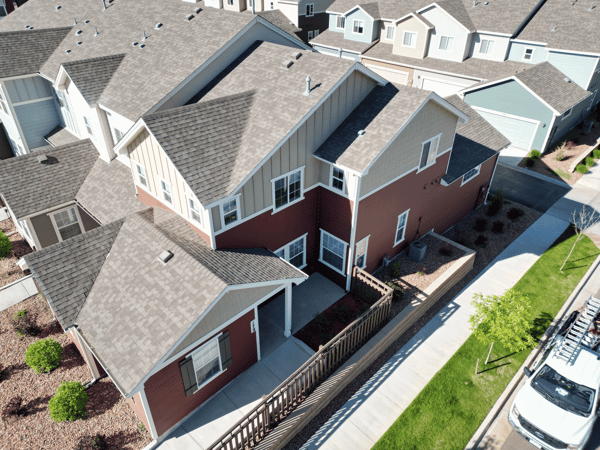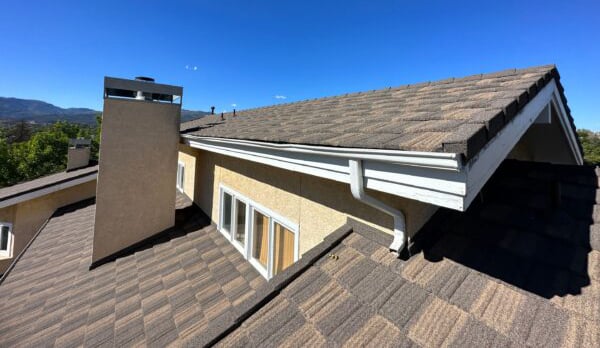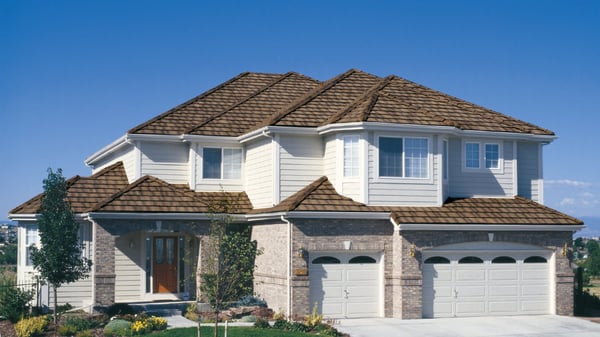Share this
Which Roof System Lasts the Longest? (and How to Choose the Right One)
by Michael Wilhelm on Nov 30, 2023 10:25:03 AM
%20(1).png?width=1200&height=800&name=Which%20Roofing%20System%20Lasts%20the%20Longest%20(5)%20(1).png)
One of the most common questions that we receive from homeowners looking to put a new roof on their home is “What roofing system lasts the longest?”
Deciding on the right roof system for your home is a crucial decision that requires careful consideration. With various options available, each boasting unique features and advantages, exploring and understanding the characteristics of different roofing materials is essential.
In this comprehensive guide, we'll delve into the strengths, weaknesses, and considerations of five popular roofing systems: Asphalt Shingles, Standing Seam Metal Roofing, Stone-Coated Steel, Concrete Tile, and Flat Roofing.
Different Types of Roof Systems
It's important to note that the average lifespan of a roof in Colorado Springs, regardless of material type, is between 15 to 20 years. With the unpredictability of the weather here in Colorado, most roofs do not reach the full lifetime that the manufacturer specifies. Barring external factors, different roofing materials can last longer.
So which roof system is the best fit for your home? Let's start by exploring the different options available.
Asphalt Shingles: The Time-Tested Favorite
With an estimated lifespan between 25 and 30 years, dimensional and designer asphalt shingles have long been a popular choice for residential roofing. Offering a winning combination of durability, longevity, and cost-effectiveness. Designed to withstand various weather conditions, from heavy rain to hailstorms, asphalt shingles provide long-lasting protection when properly installed and maintained. Their affordability makes them a budget-friendly option, making them a top choice for homeowners seeking a reliable roofing solution.

Asphalt Roofing System
Standing Seam Metal Roofing: Durability Meets Energy Efficiency
For those prioritizing longevity, standing seam metal roofing emerges as a frontrunner. With a lifespan of 40 to 70 years, these roofs outshine competitors in durability. With the inherent durability of metal as a roofing material, metal roofs are highly resistant to various environmental elements, including wind, rain, snow, and UV radiation. They are also less susceptible to issues like rot, insect damage, and mildew. Furthermore, there's the benefit of energy efficiency, reflecting sunlight to keep your home cooler, adding to their appeal. Lastly, minimal maintenance requirements make metal roofs attractive for homeowners looking for a long-lasting and eco-friendly solution. If you are local to Colorado Springs, be sure to look out for cosmetic metal exclusions on your insurance policy as these are becoming more and more common in our market.
.webp?width=600&height=337&name=Metal%20Roof%20Stock%20Photo%20(1).webp) Standing Seam Metal Roofing System
Standing Seam Metal Roofing System
Stone-Coated Steel: Unparalleled Strength and Resilience
Combining the robustness of steel with the protective layer of stone, stone-coated steel roofing delivers exceptional strength and resistance to harsh weather conditions. With a potential lifespan of up to 50 years, this roofing option proves itself as a wise investment for those in need of a durable, long-lasting solution. While the upfront cost may be higher, the payoff in terms of longevity and minimal maintenance makes it a cost-effective choice in the long run.
 Stone-coated Steel Roofing System
Stone-coated Steel Roofing System
Concrete Tile: Timeless Elegance and Exceptional Lifespan
Concrete tile roofing stands out for its exceptional lifespan and ability to withstand diverse weather conditions. Resistant to scorching heat, heavy rain, and strong winds, concrete tile roofs can endure the elements for upwards of 30 years. Though the initial cost might be higher, the longevity and minimal maintenance requirements make it a cost-effective choice in the long term, providing timeless elegance and reliable protection. Not all homes can withstand the weight associated with a concrete tile roof so be sure to speak with a qualified roofing contractor to confirm this is an option for your home.
.png?width=600&height=450&name=Concrete%20Tile%20Roofing%20System%20(2).png) Concrete Tile Roofing System
Concrete Tile Roofing System
Flat Roofing: Versatility, Energy Efficiency, and Affordability
Does your home have a flat roof? Flat roofing systems offer a unique set of characteristics, including longevity, energy efficiency, and cost-effectiveness. Flat roofs can provide reliable protection for decades with proper installation and regular maintenance. Their horizontal design allows for easy insulation, regulating home temperature and reducing energy consumption. While generally more affordable, it's crucial to note potential maintenance needs, such as inspections to prevent issues like ponding water or leaks.
Moreover, the lifespan of a flat roof can vary significantly depending on the type of flat roofing system used, the quality of installation, the materials used, and the level of maintenance. Here are some common flat roofing materials and their approximate lifespans:
- Modified Bitumen: Modified bitumen roofs, which are made of asphalt and rubber modifiers, typically have a lifespan of 20 to 30 years.
- EPDM (Ethylene Propylene Diene Monomer): EPDM rubber roofs are known for their durability and can last around 20 to 30 years or even longer.
- PVC (Polyvinyl Chloride): PVC roofs offer excellent durability and have a lifespan of approximately 20 to 30 years or more.
- TPO (Thermoplastic Olefin): TPO roofs are known for their energy efficiency and can last between 20 to 30 years.
 Flat Roofing System
Flat Roofing System
Factors to Consider When Choosing a Roof System
Choosing the right roofing system for your home involves a nuanced evaluation of multiple factors that extend beyond mere aesthetics. From the impact of climate and weather conditions to the importance of environmental considerations, roof design, ventilation, maintenance, and curb appeal, each element plays a crucial role in determining the system's longevity, energy efficiency, and overall suitability for your unique needs.
Climate and Weather Conditions
Understanding the impact of weather on different roof systems is crucial. Asphalt shingles, for instance, excel in areas with heavy rain or strong winds, while standing seam metal roofs are ideal for extreme climates with fluctuating temperatures. Stone-coated steel proves suitable for regions prone to hailstorms or heavy winds, and concrete tile roofs are perfect for areas with high temperatures or frequent storms. Flat roofing systems offer versatility but may require more frequent maintenance in specific climates.
Environmental Factors
Environmental factors such as pollution, chemical exposure, nearby industrial sites, or proximity to the coast can impact the lifespan of a roof. These factors can cause corrosion, discoloration, and deterioration of certain roofing materials. Routine inspections can give you updates on how the environment is affecting your roof.
Roof Design and Slope
Proper roof slope and drainage are paramount in preventing water pooling and potential damage from leaks and ice damming over time. Roofs that have what are referred to as dead valleys often have more leaks and water pooling over time, so it’s important to make sure these valleys are equipped with adequate drainage. Flat or low-sloped roofs often have issues with water drainage, so they typically require added waterproofing to reduce water-related issues over the life of the roof.
Roof Ventilation
Adequate ventilation plays a crucial role in the lifespan of a roof. Proper ventilation helps regulate temperature and moisture levels, preventing the buildup of heat and condensation that can lead to premature deterioration of the roof decking and rafters. Proper ventilation also prevents the nails that are securing your shingles to the roof decking from popping out and damaging the shingles.
Maintenance and Care
Regular maintenance and care are essential for prolonging the life of a roof. This includes inspecting the roof for damage, cleaning gutters and drains, removing debris, and addressing any issues promptly. Neglecting maintenance can create costly repairs out of small problems if left unchecked for too long.
Aesthetics and Curb Appeal
Beyond functionality, the aesthetic appeal of your roof is vital. Each roofing system has unique design characteristics, from the classic versatility of asphalt shingles to the sleek, modern appearance of standing seam metal roofs. Stone-coated steel offers a textured and rustic look, concrete tile provides timeless elegance, and flat roofing systems present a clean, minimalist aesthetic. Choosing a roof that complements your home's style enhances its overall appearance.

Longevity and Lifespan of Roof Systems
The longevity and lifespan of a roof system hinge on a dynamic interplay of factors, chief among them being the selection of roofing materials and the meticulous care invested in proper installation and maintenance.
Understanding Roofing Materials
When it comes to understanding roofing materials, discovering the lifespan of different roof systems is crucial to making an informed decision. Asphalt shingles last between 15 to 30 years while standing seam metal roofs boast an impressive lifespan of 50 years or more. Stone-coated steel roofing and concrete tile roofs can provide longevity of up to 50 years or more. Flat roofing systems, with proper installation and maintenance, can last for decades. Factors affecting longevity include climate, installation quality, regular inspections, and maintenance.
Proper Installation and Maintenance
Regardless of the chosen roofing system, proper installation and maintenance are key to ensuring longevity and performance. Professional installation by experienced professionals minimizes the risk of issues like leaks or premature deterioration. Regular inspections and cleanings are crucial to keeping your roof in optimal condition. Investing in proper installation and maintenance maximizes the lifespan of your roofing system and ensures its continued performance.
Cost Considerations and Return on Investment
Find out where the initial financial outlay converges with the enduring benefits, examining how a shrewd roofing choice not only enhances the resale value of your home but also amplifies its marketability, creating a harmonious interplay between economic prudence and lasting value.
Upfront Costs vs. Long-Term Savings
Balancing upfront costs against long-term savings is essential when choosing a roof system. While asphalt shingles offer affordability, options like concrete tile roofing or flat roofs may have a higher initial cost. However, their durability and minimal maintenance requirements make them cost-effective choices in the long run. Assessing both upfront costs and long-term savings helps homeowners choose a roof system that offers the best value for their investment.
Resale Value and Marketability
Investing in a long-lasting roofing system can significantly increase your home's resale value and marketability. Potential buyers often prioritize homes with well-maintained, durable roofs, eliminating the need for immediate repairs or replacements. A new or recently replaced roof enhances curb appeal, attracting buyers with a visually appealing property. Aesthetics play a crucial role in attracting potential buyers, and a roof in good condition improves the overall appearance of the property.
Expert Tips: Consult Roofing Professionals for Guidance on Choosing the Right Roof System
Consulting with roofing professionals offers numerous benefits, leveraging their knowledge and experience. Roofing experts can provide expert insights into available materials and designs, helping homeowners understand their strengths and weaknesses in relation to specific climates. Professionals can guide homeowners in choosing a roof that meets their needs, answering questions about expected lifespan, factors affecting longevity, required maintenance, and cost comparisons. A roof consultation is an opportunity to gather relevant information and make confident decisions based on professional advice.

Consideration of Personal Factors
Personal factors, including budget limitations, desired maintenance level, and future plans for the home, play a crucial role in choosing roofing materials. Budget constraints may lead homeowners to opt for affordable options like asphalt shingles, while those with more flexibility might consider longer-lasting options like standing seam metal roofs or stone-coated steel roofing. Desired maintenance levels vary among homeowners, with some preferring low-maintenance options like concrete tile roofs or flat roofing systems. Future plans for the home, whether long-term residence or selling in the near future, should also influence the choice of roofing system. Investing in a long-lasting roof can increase resale value for those planning to sell.
Conclusion
Choosing the perfect roof for your home involves carefully evaluating various factors, from climate considerations and aesthetic preferences to longevity and cost-effectiveness. Understanding the strengths and weaknesses of different roofing systems empowers homeowners to make informed decisions that align with their unique needs and preferences. By considering personal factors, consulting with roofing professionals, and prioritizing long-term value, homeowners can invest in a roof that provides reliable protection and enhances the overall appeal and marketability of their home.
Since 1979, Holladay Grace has handled every project as if it were our own home. If you’re local to the Colorado Springs community, we would be pleased to help you with all of your roofing needs.



No Comments Yet
Let us know what you think